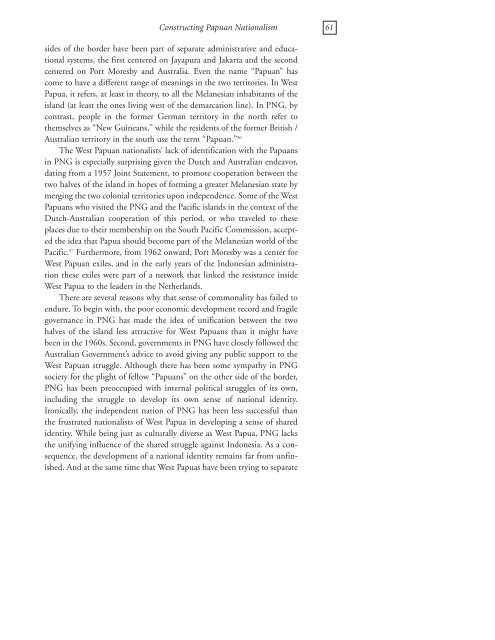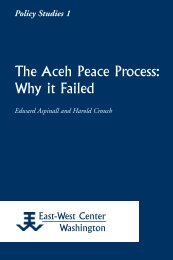Constructing Papuan Nationalism: History, Ethnicity ... - ScholarSpace
Constructing Papuan Nationalism: History, Ethnicity ... - ScholarSpace
Constructing Papuan Nationalism: History, Ethnicity ... - ScholarSpace
- No tags were found...
Create successful ePaper yourself
Turn your PDF publications into a flip-book with our unique Google optimized e-Paper software.
<strong>Constructing</strong> <strong>Papuan</strong> <strong>Nationalism</strong> 61sides of the border have been part of separate administrative and educationalsystems, the first centered on Jayapura and Jakarta and the secondcentered on Port Moresby and Australia. Even the name “<strong>Papuan</strong>” hascome to have a different range of meanings in the two territories. In WestPapua, it refers, at least in theory, to all the Melanesian inhabitants of theisland (at least the ones living west of the demarcation line). In PNG, bycontrast, people in the former German territory in the north refer tothemselves as “New Guineans,” while the residents of the former British /Australian territory in the south use the term “<strong>Papuan</strong>.” 96The West <strong>Papuan</strong> nationalists’ lack of identification with the <strong>Papuan</strong>sin PNG is especially surprising given the Dutch and Australian endeavor,dating from a 1957 Joint Statement, to promote cooperation between thetwo halves of the island in hopes of forming a greater Melanesian state bymerging the two colonial territories upon independence. Some of the West<strong>Papuan</strong>s who visited the PNG and the Pacific islands in the context of theDutch-Australian cooperation of this period, or who traveled to theseplaces due to their membership on the South Pacific Commission, acceptedthe idea that Papua should become part of the Melanesian world of thePacific. 97 Furthermore, from 1962 onward, Port Moresby was a center forWest <strong>Papuan</strong> exiles, and in the early years of the Indonesian administrationthese exiles were part of a network that linked the resistance insideWest Papua to the leaders in the Netherlands.There are several reasons why that sense of commonality has failed toendure. To begin with, the poor economic development record and fragilegovernance in PNG has made the idea of unification between the twohalves of the island less attractive for West <strong>Papuan</strong>s than it might havebeen in the 1960s. Second, governments in PNG have closely followed theAustralian Government’s advice to avoid giving any public support to theWest <strong>Papuan</strong> struggle. Although there has been some sympathy in PNGsociety for the plight of fellow “<strong>Papuan</strong>s” on the other side of the border,PNG has been preoccupied with internal political struggles of its own,including the struggle to develop its own sense of national identity.Ironically, the independent nation of PNG has been less successful thanthe frustrated nationalists of West Papua in developing a sense of sharedidentity. While being just as culturally diverse as West Papua, PNG lacksthe unifying influence of the shared struggle against Indonesia. As a consequence,the development of a national identity remains far from unfinished.And at the same time that West Papuas have been trying to separate
















